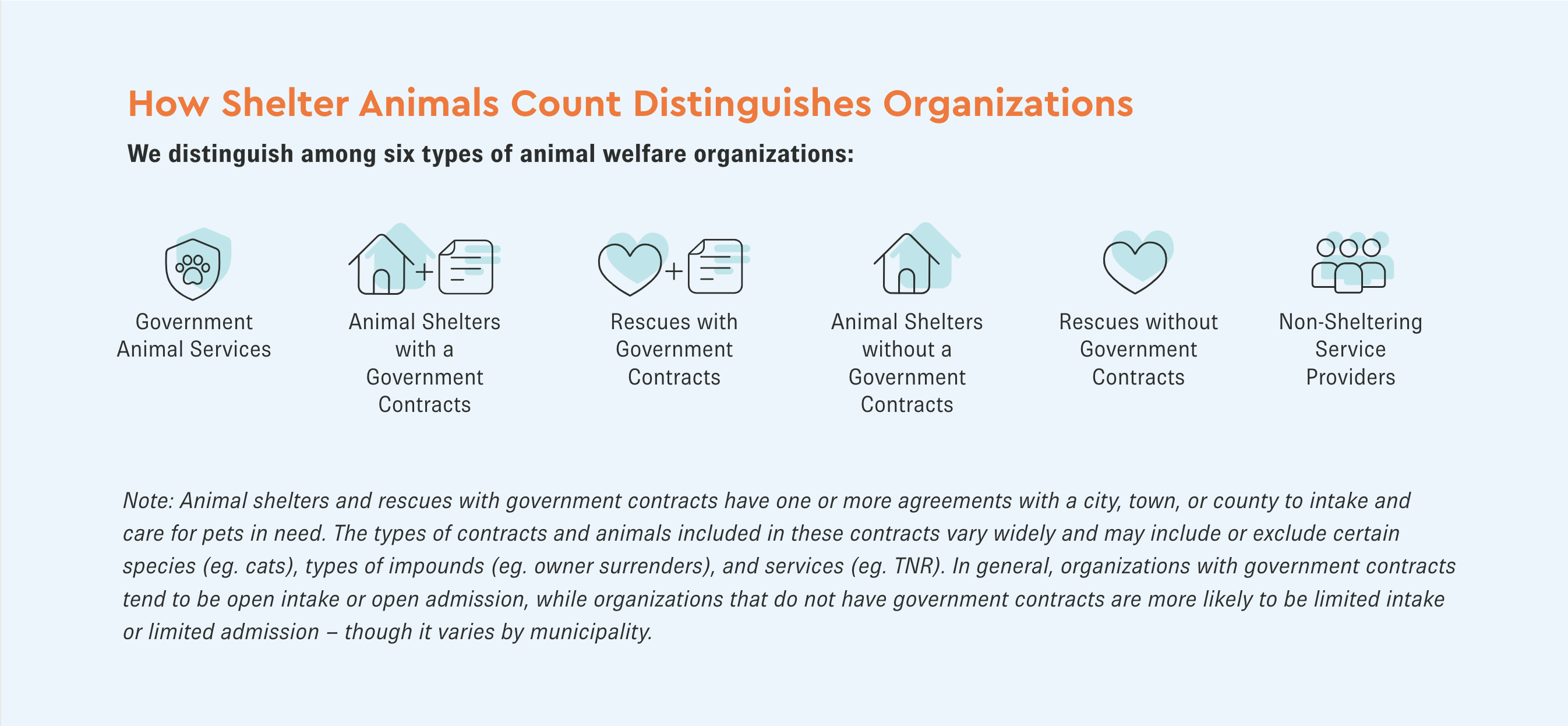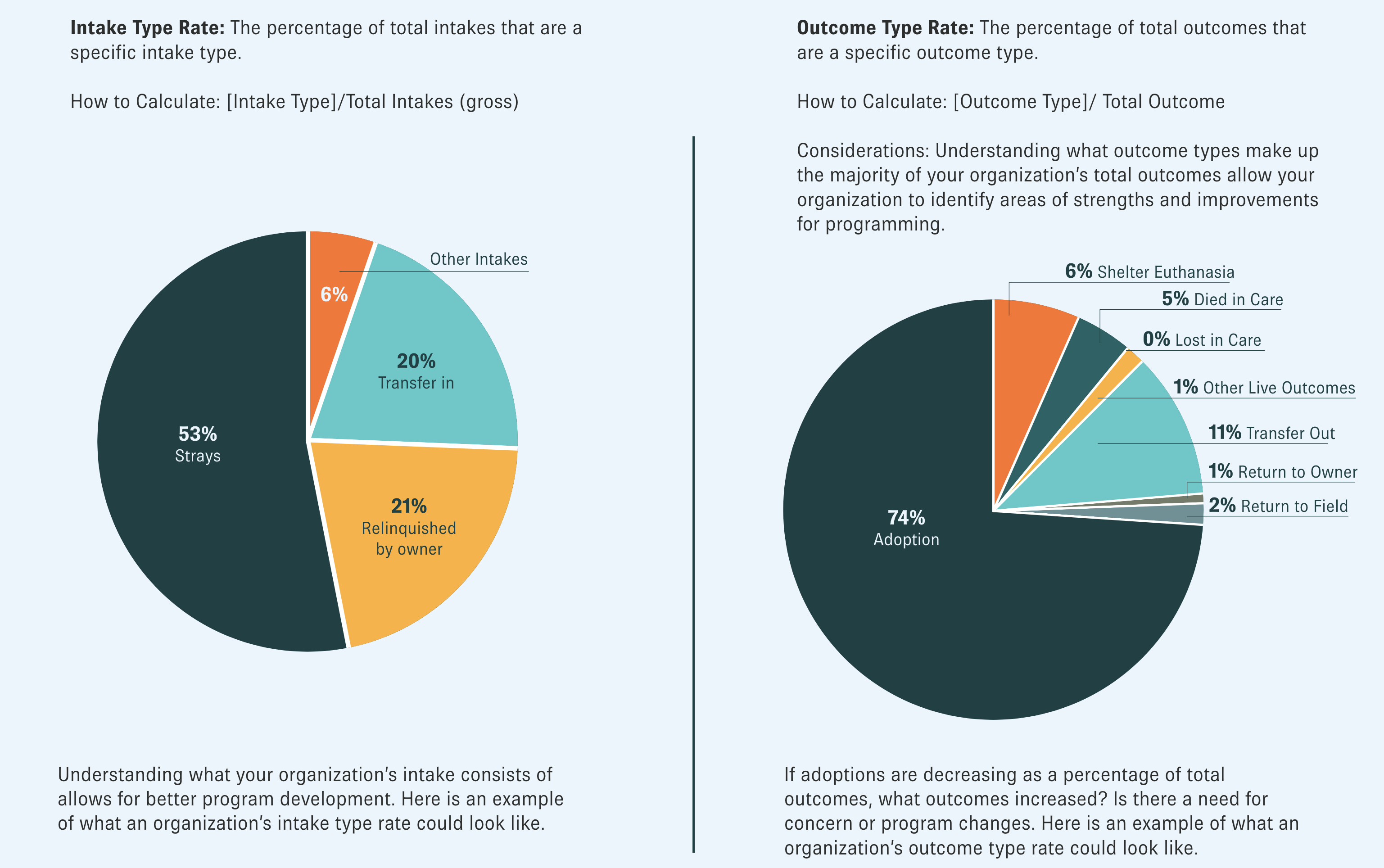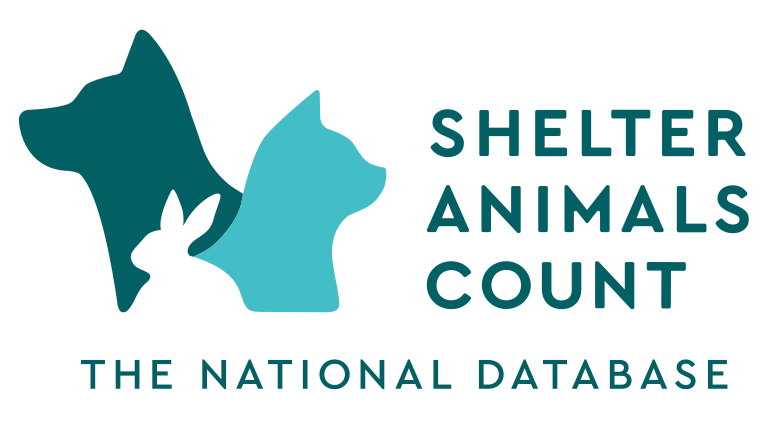
Animal Welfare Glossary by Shelter Animals Count
The Animal Welfare Glossary from Shelter Animals Count is designed to help define the terms commonly used in the animal welfare sector. Whether you are new to the industry or a seasoned professional, this glossary serves as a valuable resource to ensure a clear and consistent understanding of key terms. By providing comprehensive definitions for the various types of animal welfare organizations, intake and outcome types, and other essential terms, this glossary supports better communication, data collection, and reporting across the field.
Types of Animal Welfare Organizations (AWO)
The following are organizations that intake animals into their care:
Government Animal Shelter: A city or county-operated entity providing animal control services and housing services.
Other terms that you often see referring to this type of shelter:
• Animal Services: A term frequently used in the names of organizations or agencies that operate as animal shelters, often providing both sheltering and animal control services. These organizations are sometimes also referred to as Animal Care and Control.
• Pound: An antiquated term for a municipal or government animal shelter. It is less commonly used today, as it is tied to a period of animal sheltering when impoundment and euthanasia were the primary functions of municipal animal services.
Animal Shelter with Government Contract: A private/nonprofit agency with a contract for animal control services or housing services. A government contract is a formal agreement with a government entity for animal control and/or housing services.
Animal Shelter without Government Contract: A private/nonprofit agency with a physical facility but no government contract.
Humane Society or SPCA: Many organizations have these terms in their name. Traditionally, they are unaffiliated with national animal organizations with similar names and are nonprofit organizations that may or may not have government contracts.
Animal Rescue: Also called ‘foster-based rescue’. An animal welfare organization that houses animals exclusively in the homes of volunteers and/or staff of the organization. Rescues can also be 501(c)(3) nonprofit organizations and, in some cases, can hold full or partial contracts with government entities.
Sanctuary: A nonprofit that houses animals for the remainder of their lives. Sanctuaries can also be 501(c)(3) nonprofit organizations, and some sanctuaries also function as rescue groups that adopt some animals.

The following are entities that do not intake or house animals specifically:
Non-Sheltering Service Provider: Also called ‘non-sheltering animal welfare organization’. An agency providing direct or partnered services without sheltering animals.
Field or Animal Control Services: Entities that provide this may respond to requests in a defined service area to help animals that are lost/free-roaming, sick/injured, dangerous, or in danger, etc. Animals are housed with sheltering or community partners.
The following are categories of intake, which define how an organization processes animals entering into their care:
Open Intake: Also called ‘open admission’. An organization required by government contract to accept all animals from a service area. Most
open intake organizations are brick-and-mortar animal shelters, not rescue groups.
Limited Intake: Also called ‘limited admission’. An organization that can choose which animals to accept and is not required to accept any
from the public. Some animal shelters and most rescue groups are considered limited intake.
Managed Intake: Managed intake is a structured approach to accepting animals into a shelter, where admission is guided by specific criteria or scheduled based on the organization’s capacity to provide appropriate housing, medical, and behavioral care. This process may include offering alternatives or resources to the community (including low-cost services, supplies to care for the pet, Finder Foster, etc) when immediate admission is not feasible, ensuring animals receive the care they need at the right time.
Finder Foster Intake: A process in which the organization conducts an intake assessment of stray pets with their finders or caretakers. The pet stays with the finder for the agreed-upon hold period, helping to prevent shelter overcrowding and ensuring the pet’s well-being by keeping them in a home environment when it benefits both the animal and their caregiver. The finder has the option to voluntarily care for the pet as a foster during this time, until the pet is reclaimed by its owner or caregiver, adopted, or returned to the shelter
Intake and Outcomes
Total Intake: Also called ‘Gross Intake’. Total animals entering the organization. This includes animals moving from one animal welfare organization to another, referred to as ‘transfers in’ (see below for definition).
Community Intake: Also called ‘Net Intake’. Total animals entering the shelter minus transfers in from other organizations. Community intake is used when summing intakes in larger areas than a single organization to prevent double-counting of animals with intakes solely from transfers
among organizations. It assumes that animals transferred between organizations have already been recorded under a different intake type by the relevant organization in the data set.
Community Intakes vs Total Intakes
A shelter in Massachusetts has an intake of 250 dogs in one month, however 50 of those came from a shelter in Florida. Their total intake would be 250 dogs for the month and their community intake would be 200 dogs.
Intake Types
Stray: Also called ‘at-large’. Animal stated to be unowned, free-roaming, or owner not present. Animal is held for a legally mandated period that must be kept in the custody of an organization to allow for the animal to be returned to its owner or caregiver. Note: Please refer to the definition of trap-neuter-return for animals brought in as strays with the intent of being returned to their original community.
Relinquished by Owner: Also called ‘owner surrender’. Animal admitted by its owner, including adoption returns.
Seizure/Confiscate: Pets impounded by animal control or law enforcement due to neglect, cruelty, ordinance violations, police arrests, evictions, or other legal circumstances are housed at the organization for a specific period as mandated by state and local laws. These pets may be either owned or stray.
Intake Type Processes from the Community
Over-the-Counter: Also called Public Drop Off. Animal is brought into the organization by a community member. These can be stray animals or owner-relinquishments.
From the Field: Animal is brought into the organization by an animal control officer or law enforcement. These can be stray animals, owner relinquishments, or animals seized by an animal control or other law enforcement officer.
Transfer In: Animal transferred into the organization’s possession from another organization.
Other Intakes: Pets born in care or other types of intakes not listed above.
Outcomes
Total Live Outcomes: Sum of animals that left the organization’s care through a live placement.
Community Live Outcomes: Sum of animals that left the organization’s care through a live outcome type minus transfers to another animal welfare organization.
Total Non-Live Outcomes: Sum of animals that left the organization’s care via a non-live outcome. This includes died, missing, and euthanized.
Total Outcomes: Includes all outcomes including adoptions, return to owner/field, other live outcomes, transfers out, shelter euthanasia, died in care/lost in care
Outcome Types
Adoption: Animal custody permanently transferred from the organization to an individual adopter via an adoption process.
Return-to-field (RTF): Return-to-field as an outcome type is the return of felines taken into the organization, counted as stray intake and then returned to their capture location as free roaming felines. This is only for felines brought into the organization as a stray without the intention of having them returned to where they were found. Return-to-field is an outcome decision made by the organization.
Transfer Out: Animal custody transitioned to another organization. Entities may include local rescue partners or national groups.
Return to Owner (RTO): Also called ‘Return to Home’ or ‘RTH’. Animal returned to its owner after being processed as an intake.
Other Types of Outcomes:
Lost in Care: Animal outcome is unknown. This is also referred to as ‘missing’ and may include stolen animals.
Died in Care: Animal died, unassisted, while in the custody of the organization.
Shelter Euthanasia: Animal euthanized in the custody of the organization.
Services That Can Be Intakes and Outcomes
Owner Intended Euthanasia (OIE): Also called “Owner Requested Euthanasia” or “ORE”. This term refers to situations where an owner
brings their pet to the shelter or community clinic specifically requesting euthanasia due to a medical or behavioral issue. It does not
include cases where a pet is surrendered without an intent for euthanasia, and the shelter later decides on that outcome
Standardizing the Data
Shelter Animals Count recommends standardizing data by treating Owner Intended Euthanasia as a community service rather than including it in intake/outcome analyses.
Since July 1, 2022, Shelter Animals Count has recorded Owner Intended Euthanasia (OIE) as a community service, reflecting its primary purpose as a support to the community. Shelters can still choose to log OIE as either an intake/outcome or as a community service in our system. If logged as an intake/outcome, the data appears in the organization’s individual Intake/Outcome dashboards (see definitions) only and does not appear in aggregate intake/outcome public dashboards. All OIE data appears in our Community Services dashboard (see definitions). For standardized reporting, OIE data is combined and reported solely as a community service in all Shelter Animals Count publications. This approach applies to both new and historical data, and organizations can update their historical records through the SAC portal if needed.
Services That Are Not Intakes and Outcomes
Trap-Neuter-Return (TNR): When a cat is brought to an organization or one of their contracted spay/neuter providers for the purpose of sterilization and ultimately return to where it was found.
Return to Owner in Field: A pet that is found by animal control or shelter staff while in the community and returned to their owner without entering the organization or processing as an intake.
Shelter Animals Count advises that you report Trap-Neuter-Return and Return to Owner in Field data as a service in our Community Services Dashboard.
Common Calculations
Population Balance Calculation: The percentage of total intakes that have had an outcome.
The Population Balance Calculation
The Population Balance Calculation (PBC) is a simple formula used by Shelter Animals Count to understand whether a shelter’s animal population is growing, shrinking, or staying the same over a given period. It’s calculated by dividing the total number of animals leaving the shelter (outcomes) by the total number coming in (intakes).
Here’s what different PBC percentages mean:
• 100%: The shelter is in balance. Animals are leaving at the same rate they’re arriving, so the overall population isn’t changing.
• Under 100%: The population is increasing. For example, a PBC of 97% means that 3% more animals entered the shelter than left it, so some animals stayed behind.
• Over 100%: The population is decreasing. For example, a PBC of 107% means that 7% more animals left than entered, reducing the shelter population.
Example
From January to June 2024, the overall PBC was 94.2%, indicating that slightly more animals came into shelters than were leaving, which increased the population. The PBC helps shelters and communities quickly understand whether they are keeping up with animal intake, allowing them to plan resources and strategies effectively.
Start Count: The number of animals in your care on the first day of the period of time selected.
End Count: The number of animals in your care on the last day of the period of time selected.
When tracking data, consider these key points for measuring your organization's metrics:
- • Beginning Count Total in Care
- • Beginning Count in Foster
- • Beginning Count in Shelter
- • Ending Count Total in Care
- • Ending Count in Foster
- • Ending Count in Shelter
Length of Stay (LOS): Calculated as the number of days from intake to outcome for animals that have already had a permanent outcome.
Example
An example of Length of Stay: A pet arrives at your organization as a stray on January 1. The pet serves a 5 day mandated stray hold period and is adopted on January 10th. Their length of stay would equal 9 days.
Days in Care: The number of days that an animal has been in the organization’s care from the date of the initial intake and has not had a permanent outcome.
Example
An example of days in care: You have a pet in your shelter that arrived on May 1st. The pet is still in your care at the shelter on May 10th. The days in care for that pet would equate to 10 days.
When analyzing data for multiple animals, you can use averages or medians to understand population trends.
• Averages give a central value for the group but can be influenced by outliers. For example, if one animal has a much longer or shorter length of stay than the others, it can distort the average.
• Medians are a better choice when outliers are present because they represent the middle value in the data, providing a more accurate picture of typical trends.
The following definitions are metrics that are just one part of assessing outcomes and should not be used as the sole measure of success. When used independently, Shelter Animals Count recommends prioritizing live outcome measurement at the community level rather than limiting the focus to the shelter level.
Live Release Rate: The percentage of animals with an outcome that leave with a live outcome. Calculated as live outcomes/total outcomes.
Save Rate: The percentage of animals entering an organization that do not leave by a non-live outcome. It is calculated by taking your
Total Intakes minus Non-live Outcomes divided by Total Intakes.

Days in Care: Outcome Type Rate of Total Intakes: The percentage of animals entering the shelter that are leaving by a certain
outcome type.
How to Calculate: [Outcome Type]/ Total Intakes (gross)
Considerations: Outcome as a percentage of intake allow you to see that portion of animals coming into your organization’s care, leave
by a specific outcome.

Note: Outcomes as a percentage of intake allow you to see what portion of animals actually coming into your organization’s care,
leave by a specific outcome. If your intake is decreasing, outcomes will also decrease. Therefore, if you look at the outcome rate of
intake, you may find that more animals entering the shelter are leaving via specific outcomes.
Animal Information
Altered/unaltered: Also called ‘sterilized/unsterilized,’ or ‘spayed/neutered/intact.’ The animal’s reproductive status. This status may be
updated during the animals’ stay so this will not necessarily indicate which animals were spayed or neutered on intake.
Intake Date: The date the animal entered the organization’s custody.
Intake Subtype: A more specific description of why the animal is in the organization’s custody.
Intake Reason: The reported reason the animal is in the organization’s custody. The list of possible reasons vary widely among shelters.
Outcome Date: The date the animal left the organization’s custody.
Outcome Subtype: A more specific description of why the animal is no longer in the organization’s custody.
Outcome Reason: The reported reason the animal is no longer in the organization’s custody. The list of possible reasons vary widely among shelters.
Sex: The sex of the animal.
Size: The animal’s approximate size classification.
Species: The species of the animal.
This varies on the species that your organization serves. Can include: Dog, Cat, Guinea Pig, Rabbit, Horse, Pig, Bird, and so on.
Animal Ages:
Based on software, here are common ways that animals can be aged in your system:
Date of Birth: The reported or estimated birthdate of the animal. This is often an estimate or guess based on appearance and teeth.
Intake Age (Group): The animal’s age group at intake.
Animal Details:
Breed (Primary): The animal’s primary breed, usually only determined by physical appearance and a breed guess.
Breed (Secondary): The animal’s secondary breed, if applicable. When selecting breeds, it’s important to list them in a way that provides
value to potential adopters, helping them make informed decisions and it helps with your data tracking on what is coming into your shelter.
Tip: Adopt-a-Pet has a great resource for Dog Breeds that you can view here.
Color (Primary): The animal’s primary color.
Color (Secondary): The animal’s secondary color, if applicable. When selecting colors, it’s important to list them in a way that provides
value to potential adopters and it helps with your data tracking on what is coming into your shelter.
When selecting colors, it’s important to list them in a way that provides value to potential adopters and it helps with your data tracking on what is coming into your shelter.
Community Services Definitions and Metrics:
The following definitions and metrics are captured as part of our Community Services Database.
Community Services: Services provided by organizations to support pets and people in our communities.
Intake Diversion: Animal is not processed as an intake due to programs in place to keep the pets with their families or return them to their home/colony.
Field Services: Services provided by organizations to care for managed community pet populations such as community cats and animals returned to their owner without entering the shelter
Field Services Metrics:
Trap-Neuter-Return: When a cat is brought to an organization or one of their contracted spay/neuter providers for the purpose of sterilization and ultimately return to where it was found.
Return to Field: Return-to-field as an outcome type is the return of felines taken into the organization, counted as stray intake and then returned to their capture location as free roaming felines. This is only for felines brought into the organization as a stray without the intention of having them returned to where they were found. Return-to-field is an outcome decision made by the organization.
Behavioral Services: Low-cost/free behavior programs and services to assist community members with pet behavior issues that otherwise may lead to that animal coming into the shelter.
Behavioral Services Metrics:
Behavioral Consultation: Owned animals receiving behavior consultation in-person, by phone or online. Limited to this definition: Consult is provided as free or low-cost community service.
Group Training: Owned animals receiving training in a group setting. Limited to this definition: training provided as a free or low-cost community service. Training classes can be provided directly by an organization or indirectly with a voucher for a private business.
Private Training: Owned animals receiving training in a private setting. Limited to this definition: Training provided as a free or low-cost community service, not all training classes provided by an organization.
Behavior Modification Program Owned animals receiving behavior modification in a private setting. Limited to this definition: Training provided as a free or low-cost community service, not all training classes provided by an organization.
Veterinary Services: Veterinary services are provided to owned/community pets at free/low cost. Includes microchipping, spay/neuter, preventative wellness care, basic and advanced medical care.
Veterinary Services Metrics:
Microchipping and/or Collar with ID Tags: Animals receiving insertion of microchip an/or application of long-wearing collar with identification, as well as registering microchip/recording identification
Spay/Neuter for Owned Animals: Owned animals receiving spay/neuter services. Trap-Neuter-Return is not counted here.
Wellness/Preventative Medical Care: Routine preventative care provided to healthy pets and/or same treatments provided to mildly affected pets (vaccinations, routine deworming, flea tick treatment, heartworm preventative etc.)
Sick Animal Care/Basic Veterinary Care: Minor medical or surgical care provided to pets with a condition requiring a single course of treatment (i.e. dentistry, tooth extraction, minor heartworm disease, routine skin allergy, ear infection, etc.)
Sick Animal Care/Advanced Veterinary Care: Animal presents with illness as complaint and illness requires more than routine preventative medical care or surgical care to address. Condition requires ongoing or chronic care, or hospitalization to prevent death/disability. (i.e. fractures, chronic diarrhea, URI, parvo, diabetes, cancer, etc.)
Owner Intended Euthanasia: Also called “Owner Requested Euthanasia” or “ORE”. This term refers to situations where an owner brings their pet to the shelter or community clinic specifically requesting euthanasia due to a medical or behavioral issue. It does not include cases where a pet is surrendered without an intent for euthanasia, and the shelter later decides on that outcome
Support Services: Retention and rehoming support provided to community members to ensure their pets can stay in the home, return to home, or find new placement without entering the shelter
Support Services Metrics:
Pet Food: Animals receiving pet food through pet pantries or similar services
Pet Supplies: Animals receiving leashes and collars, cat carriers, or other supplies .
Grooming: Animals receiving grooming services
Temporary Housing: Animals receiving temporary short- or long-term housing WITHOUT their owner
Temporary Housing for People and Animals: Animals receiving temporary short- or long-term housing WITH their owner
Other Pet Retention Services: Animals receiving other support not captured above (i.e. fence repairs/builds, dog houses, pet deposits)
Rehoming Support: Animals receiving rehoming assistance outside of the owner relinquishment or other shelter/rescue intake
